AI vs ML vs DL: Key Differences and Real-World Applications 2025
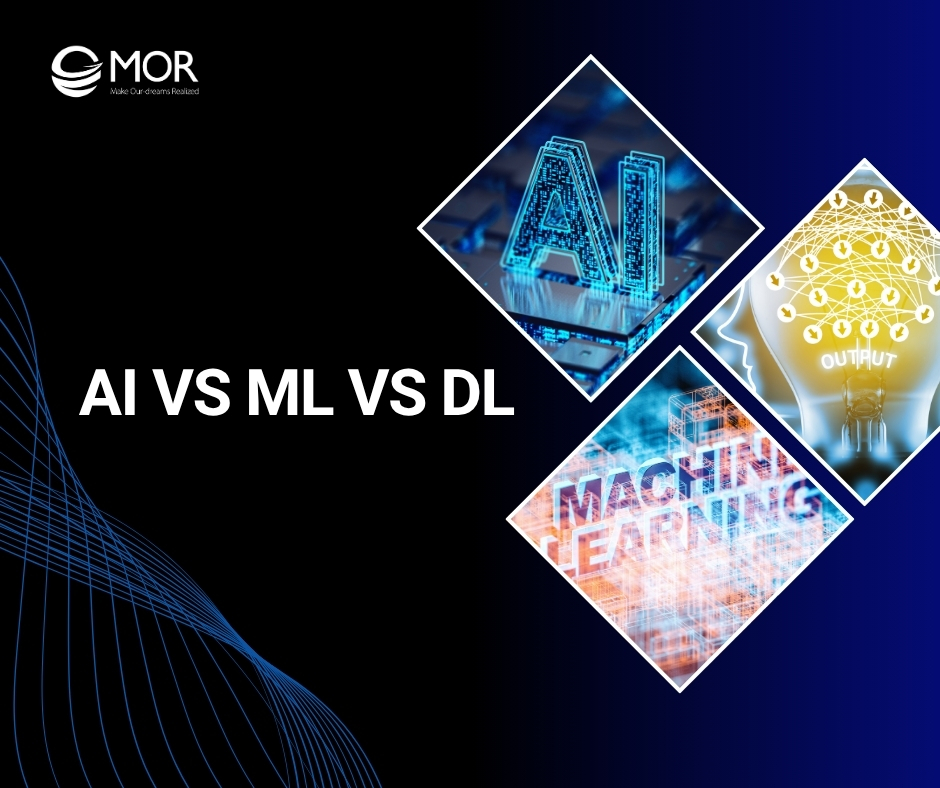
Many teams still struggle to explain the difference between AI vs ML vs DL, let alone choose the right one for their business. Confusion grows even more when terms like ai vs ml vs dl vs llm or ai vs dl vs ml are thrown into the mix. This MOR Software’s guide will break down each term clearly, compare their real-world applications, and help you decide which technology fits your goals in 2025.
What Is AI, Machine Learning, Deep Learning?
What Is AI?
Definition Of AI
Artificial Intelligence (AI) is the concept of building machines that act and think like humans. It uses machine learning algorithms, models, and large sets of data to solve problems, spot patterns, and make decisions.
Whether it’s answering questions, sorting images, or flagging spam emails, AI can perform tasks with speed and accuracy that often outpace human effort. It helps cut down bias, save time, and lower costs.
Among companies that adopted it last year, 71% said they regularly used generative AI in at least one business function.
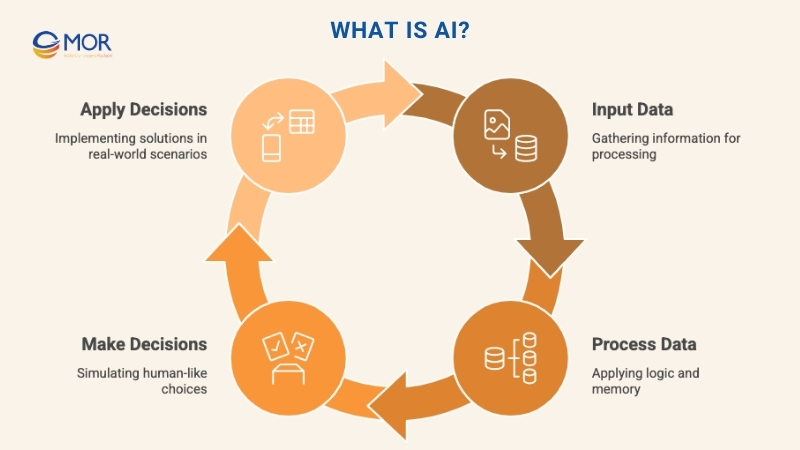
When Is AI Used?
You’ll find AI in action whenever a system mimics human decision-making. Take Roomba, the robotic vacuum. It scans the room, identifies walls and obstacles, then maps out the best path to clean efficiently.
That’s not random motion, it’s a learned behavior based on input, logic, and memory. It’s also a classic case of artificial intelligence models in the real world.
Other real-life examples? AI now supports mental health diagnostics, offering early intervention through voice and behavior analysis. It’s also transforming how companies hire, using smart screening tools to match candidates faster and fairer.
In media, recommendation engines already shape behavior at scale, for example, Netflix has reported that roughly 80% of viewing hours come from its recommendations.
Now that we’ve covered AI, let’s explore the next layers: machine learning and deep learning. This helps complete the full picture of ai vs ml vs dl vs dl in 2025.
What Is Machine Learning?
Definition Of Machine Learning
Machine learning (ML) is a branch of artificial intelligence that teaches machines to learn from data instead of being manually programmed. It builds models that recognize patterns or make predictions based on experience.
Using methods from statistics, physics, neural networks, and more, machine learning systems figure things out on their own, no fixed rules needed.
Picture a software tool assigned a task, like detecting fraud. Instead of feeding it every possible fraud scenario, you give it relevant data and a training model.
Over time, the software learns to recognize what fraud looks like and improves as it sees more examples. That’s ML in action. In short, this is where we begin to see the first clear split in ai vs ml vs dl vs data science.
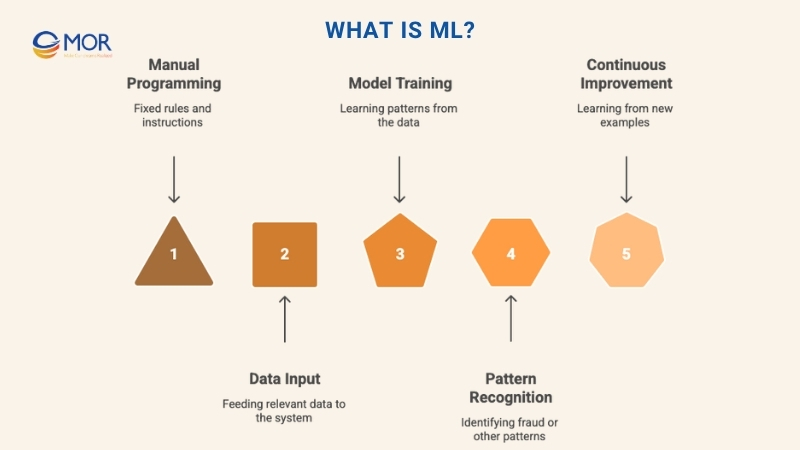
Regularization and Machine Learning
When machine learning models try too hard to fit every single data point, including random noise, we call it overfitting. That hurts prediction quality. Regularization solves this.
It limits how much weight the model can assign to specific variables, making results more general and accurate. It’s especially useful with massive data sets where not every detail matters.
By adjusting coefficients toward zero, regularization helps machine learning stay focused on real patterns instead of distractions. The result? More reliable, less over-engineered predictions.
When To Use Machine Learning
Use machine learning when you want a system to make decisions or spot patterns based on structured input. It’s ideal for things like recommendations, fraud detection, or inventory planning. Spotify’s "Discover Weekly" is a simple but smart use case.
It tracks your preferences, compares them with others who have similar taste, and builds a playlist just for you. In financial services, 83% of banks report using ML to detect financial crime, a sign that pattern recognition on structured data is now standard practice.
This kind of automation is exactly what differentiates ai vs ml vs dl example use cases.
Structured vs Unstructured Data in ML
Structured data is clean, organized, and easy for machines to work with. Think rows in a spreadsheet: names, dates, prices. It’s quick to search, sort, and analyze. ML thrives on this because the format is predictable.
Unstructured data, like photos, videos, or voice messages, has no defined format. It’s flexible and rich, but tricky to process. This is where deep learning becomes more useful than traditional ML.
Understanding the difference in how these two types of data are handled adds depth to any discussion about ai ml dl systems and their real-world use.
Key Benefits Of Using Machine Learning
Accurate Forecasting
Machine learning is excellent at making predictions based on structured data. Companies use it to forecast demand, track market trends, and predict customer behavior. It can even help estimate delivery times, shipping costs, or seasonal fluctuations.
Since forecasting deals with organized, historical data, ML models are the right fit, deep learning tends to struggle here. This is a clear case where understanding ml vs dl can guide the tech choice.
Automation
Once trained, ML models run with little to no human help. They process massive data sets, spot insights, and generate outcomes quickly. What’s more, they learn from every result, improving over time without being manually updated. That’s a big advantage over deep learning, which usually needs more tuning and oversight early on.
Trend and Pattern Recognition
Humans miss things, especially in huge spreadsheets. ML doesn’t. It scans structured data at scale, surfacing patterns and relationships we might never spot. Artificial intelligence ml dl comparisons often overlook this, but ML shines when it comes to uncovering hidden signals in clean, labeled data.
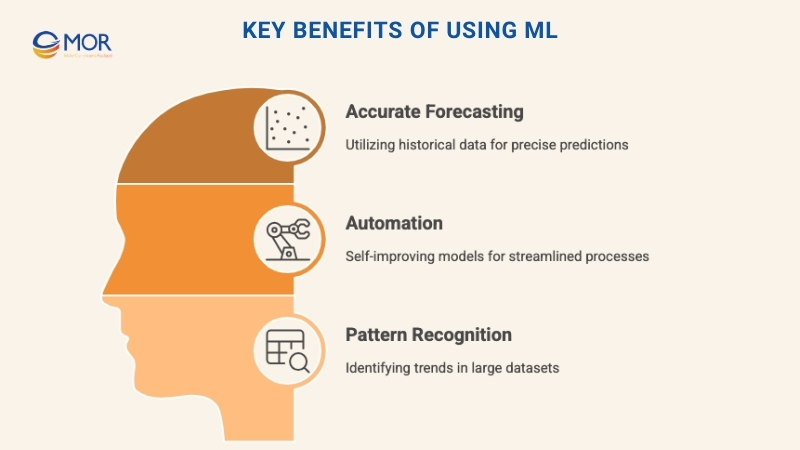
Machine Learning Applications
Chatbots
Many smart chatbots rely on machine learning to deliver useful responses. They pull from structured data, like chat logs or FAQs, to answer questions and refine replies over time. While some use deep learning for voice or tone recognition, the logic behind matching questions to answers is ML territory.
This is another place where the distinction between ai vs ml vs dl vs generative ai becomes clear.
Educational Tools
Apps that help you learn languages or prep for exams often use ML to personalize lessons. They review your past answers and adjust the next steps to fit your strengths and weaknesses. It’s structured, measurable, and focused on pattern recognition, all strengths of machine learning.
Streaming Platforms
Streaming services like Netflix and Spotify use ML to build your recommendation list. The system checks what you’ve watched or listened to, compares that with what similar users liked, and suggests new content. Since this is based on structured user behavior, deep learning isn’t needed here. ML does the job well.
Now that we’ve walked through how machine learning works and where it fits, let’s move to the next layer: deep machine learning. This will round out our comparison of ai vs ml vs dl vs llm.
What Is Deep Learning?
Definition Of Deep Learning
Deep learning (DL) is a specialized type of machine learning built on complex neural networks that mimic the way the human brain works. These models are layered, with each layer learning something different from the data. The more layers, the more complex the patterns the model can recognize.
Rather than just finding simple trends in structured data like ML, deep learning focuses on solving difficult problems hidden in unstructured data. Recent benchmark results highlight how quickly deep models are advancing, for instance, AI systems improved on the SWE-bench code task from 4.4% solved in 2023 to 71.7% in 2024.
It’s used in high-stakes systems like facial recognition, defect detection in manufacturing, or advanced image processing. This is where ai vs ml vs deep learning becomes more than just theory, it shows up in the real world.

When To Use Deep Learning?
Use deep learning when the task involves unstructured data, like photos, videos, or voice recordings. These types of data don’t fit neatly into rows and columns, which makes them hard for traditional ML to handle.
Take facial recognition. DL systems analyze thousands of facial images, break them down into features like eye shape or jawline, and learn how to match them to known faces. It’s not just about spotting a face, it’s about interpreting pixels, lighting, and angles. That level of precision is why DL outperforms ML in this space.
This kind of image classification is a perfect fit when comparing ai vs ml vs dl vs generative ai, DL handles complex, unstructured inputs better than the rest.
Key Benefits Of Deep Learning
Efficiently Handles Unstructured Data
Deep learning shines where machine learning starts to fall short, handling unstructured data like images, audio, and handwriting. ML models often miss the deeper insights buried in this kind of input. But DL models are built for it.
Businesses that work with large amounts of raw, unorganized data can train DL systems to extract value that would otherwise go unnoticed. That’s why in any breakdown of ai vs ml vs dl vs data science, DL is the go-to for unstructured data analysis.
Scalability
DL models aren’t just powerful, they’re scalable. They can process huge volumes of data all at once and adapt quickly to growing workloads. Tools like Google’s Cloud AI use deep neural networks to handle batch predictions at scale, adjusting resources based on traffic.
That kind of flexibility helps businesses move faster without rebuilding their systems. It also supports use cases where artificial intelligence models need to operate at enterprise levels.
Parallel and Distributed Algorithms
One of DL’s biggest strengths is how well it works with parallel and distributed algorithms. Instead of relying on a single machine, DL training can be split across many. This speeds up the time it takes to train large models and cuts costs.
For teams working with massive datasets, this isn’t a bonus, it’s a necessity. It’s also a key reason why DL leads the way in advanced workloads when comparing ai vs dl vs ml in real-world scenarios.
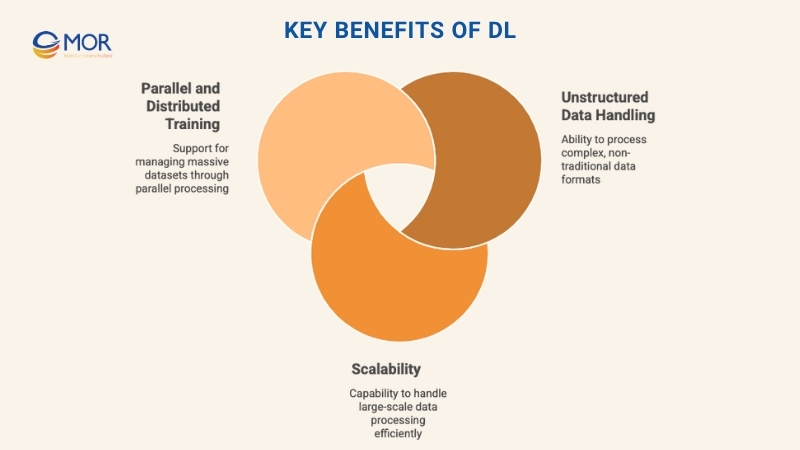
Deep Learning Applications
Virtual Assistants
Deep learning powers virtual assistants like Siri, Alexa, and Google Assistant by enabling advanced Natural Language Processing (NLP). These systems interpret unstructured data, spoken or typed words, then deliver a response that fits your intent.
Whether it’s understanding your accent, detecting emotion in your tone, or picking up on context, DL helps make the interaction more natural. That’s why when working with language-based input, deep learning outperforms ML. It’s a strong case in the broader debate of ai vs ml vs dl example use cases.
Self-Driving Vehicles
Autonomous vehicles rely on deep learning to function safely. These systems collect real-time data from cameras, GPS, LiDAR, and radar sensors. DL models process this massive stream of unstructured input to help the car 'see' and make decisions.
They identify people, traffic signs, buildings, and other vehicles, then decide what to do. DL also supports visual odometry, helping the car estimate its position as it moves. This is one of the most complex ai ml dl applications in practice today.
Manufacturing
In manufacturing, deep learning is changing how companies detect flaws and maintain equipment. Traditional ML can’t handle the variety and complexity of data like DL can. Think visual scans of product surfaces, pressure readings, or thermal imagery, DL models use anomaly detection to catch problems early.
That means less downtime, fewer defects, safer conditions, and higher output. This shows how ai vs ml vs dl vs llm applies beyond tech and into heavy industry.
What Are the Differences Between AI Vs ML Vs DL?
Though often used interchangeably, artificial intelligence, machine learning, and deep learning follow a clear hierarchy. Deep learning sits within machine learning, which itself is a subset of artificial intelligence. What sets them apart is how they learn, the kind of data they use, and how much human effort is needed for setup.
We’ve broken down their core differences below to help you make sense of ai vs ml vs dl in practical terms:
Feature | Artificial Intelligence (AI) | Machine Learning (ML) | Deep Learning (DL) |
Scope & Definition | Broadest category. Builds systems that replicate human thinking and behavior, like problem-solving and learning. | A type of AI focused on systems that learn from data without being manually reprogrammed for every scenario. | A form of ML using layered neural networks to understand patterns in raw data. |
Goal | Simulate human intelligence in machines. | Teach machines to learn from data and perform specific tasks well. | Automatically learn features from data to solve complex problems more accurately. |
Approach | Uses logic, rules, optimization, and learning algorithms (including ML and DL). | Uses models like Decision Trees, Linear Regression, and SVM to analyze structured data. | Uses deep neural networks inspired by the human brain. |
Data Requirements | Depends on the system. Some rule-based AI needs very little data. | Needs large amounts of structured or labeled data to train effectively. | Needs massive datasets to work well, often millions of examples. |
Hardware Needs | Varies widely. Basic AI can run on minimal systems. | Often works on regular CPUs, but heavy models may need better hardware. | Requires GPUs or TPUs to handle complex network training across large datasets. |
Feature Engineering | Depends on the technique used. | Usually needs humans to select and refine input features manually. | Extracts features automatically from raw data, reducing manual effort. |
Training Time | N/A for rule-based AI. Training time varies for ML/DL-based models. | Faster than DL for most tasks, training may take seconds to hours. | Slower due to deeper architecture, training can take hours, days, or longer. |
Interpretability | Simple rule-based systems are easy to explain. Complex ML/DL models are harder to interpret. | Easier to explain with simple models (e.g., decision trees). Complex ensemble methods are less transparent. | Often opaque. It’s difficult to trace how the model reached a specific decision. |
Use Cases | Virtual assistants, problem-solving bots, chess engines, general automation. | Streaming recommendations, spam filters, fraud detection, structured medical data analysis. | Facial recognition, language translation, speech-to-text tools, autonomous vehicle perception, medical image analysis. |
This structured view highlights how these fields stack together and why choosing the right one depends on your data, goals, and infrastructure. It also adds clarity when comparing ai vs ml vs dl vs llm and understanding which approach fits which problem.
In short, AI is the big picture, ML is how machines learn from data, and DL is the deepest layer that allows them to think almost like humans.
Think about three levels of “intelligence” in a smart vacuum cleaner:
1. Basic Level — AI (Artificial Intelligence)
The robot follows pre-programmed rules:
- When it bumps into a wall, it turns.
- When the battery is low, it returns to charge.
- When cleaning is done, it stops automatically.
These are simple, rule-based vacuum cleaners (usually priced around $100–200). They seem “smart” but don’t actually learn. This is AI in its most basic form.
2. Intermediate Level — Machine Learning (ML)
This version learns from experience:
- Remembers your room layout after a few cleanings.
- Detects which areas need cleaning more often.
- Adjusts suction power in dusty spots.
These are the “smart mapping” vacuums using sensors and data from repeated runs. This is machine learning, where the robot improves through experience.
3. Advanced Level — Deep Learning (DL)
The highest tier uses cameras and neural networks to understand its surroundings:
- Recognizes cables, shoes, and pets, and avoids them.
- Detects floor types and adjusts cleaning modes.
- Responds to voice commands or app instructions.
This is deep learning in action. The vacuum doesn’t just follow patterns; it interprets visual and environmental cues. These premium models are the most expensive but also the most autonomous.
What Is The Relationship Between AI Vs ML Vs DL?
Understanding the link between AI vs ML vs DL helps make sense of how they support each other. These three aren’t separate technologies. They’re layered. In 2024, 78% of organizations reported using AI in at least one business function, which shows how these layered capabilities are now deployed widely across enterprises.
Artificial Intelligence (AI) is the broadest concept. It’s the idea that machines can perform tasks that would normally require human thinking, like making decisions, recognizing speech, or translating text.
Machine Learning (ML) is a branch of AI. It focuses on helping machines learn from data and improve over time. Think of it like this: you feed a model weather data from the past year, and it learns to predict temperatures or rainfall for the next week. As new data comes in, the model adjusts. That ability to 'learn' and adapt is what makes it ML.
Deep Learning (DL) is one level deeper. It’s a type of ML that relies on neural networks, which are designed to simulate how the human brain processes information. These models handle vast amounts of data and extract patterns on their own. In real life, this might look like a self-driving car using deep learning and computer vision to spot pedestrians or traffic signs.
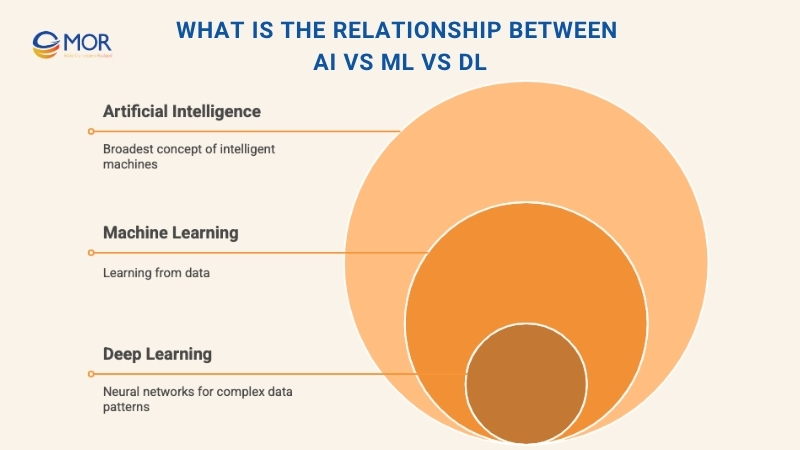
To sum it up, deep learning is part of machine learning, and machine learning is part of artificial intelligence. You can’t talk about ai vs ml vs dl without understanding this nested structure.
In recent years, these layers have expanded into new territory with Generative AI and Large Language Models (LLMs). Generative AI uses deep learning to create new content such as text, images, or music, based on what it has learned from massive datasets. LLMs, such as Generative Pre-Trained Transformers (GPT), represent a specialized type of generative AI trained to understand and generate human-like language. ChatGPT, built on the GPT architecture, is a practical example that brings all these layers together: AI for reasoning, ML for learning, DL for pattern recognition, and LLMs for fluent text generation.
MOR Software Helps Businesses Apply AI vs ML vs DL
MOR Software helps businesses turn the concepts of AI automation, ML, and DL into real, working solutions. We don’t just explain the differences. We build systems that use them the right way.
Need to automate tasks with structured data? We design and deploy custom AI solutions. Want smarter pattern recognition or voice/image analysis? Our team delivers deep learning apps that scale. From chatbots to recommendation engines to predictive analytics, we match your needs with the right tech.
We also make sure everything fits into your current systems. That means clean integration, secure infrastructure, and advice on the best stack for your goals. Whether you’re early in the AI journey or scaling up, we can help move faster with fewer risks.
Contact our AI team to explore what’s possible.
Conclusion
Understanding AI vs ML vs DL is about knowing which tool solves which problem. Artificial intelligence gives us the big picture, machine learning adds adaptability through data, and deep learning pushes the boundaries with unstructured input and complexity. At MOR Software, we help businesses apply the right solution at the right stage. If you're ready to explore how these technologies can support your business, contact us today.
MOR SOFTWARE
Frequently Asked Questions (FAQs)
What is the difference between AI and ML and DL?
Artificial Intelligence (AI) is the broad field focused on creating systems that simulate human thinking.
Machine Learning (ML) falls under AI and gives systems the ability to learn and improve from data.
Deep Learning (DL), a subset of ML, uses layered neural networks to manage complex tasks like voice and image recognition.
Is ChatGPT ML or DL?
ChatGPT is built using deep learning techniques. It relies on a transformer-based neural network architecture trained on massive datasets, allowing it to understand language patterns and generate human-like responses. So, while it falls under the category of machine learning, it specifically uses deep learning.
What is the difference between AI, ML, DL, and Generative AI?
AI is the overarching field that covers all machine-based intelligence.
ML is a part of AI where systems learn from data.
DL is a deeper level of ML that uses neural networks for complex tasks.
Generative AI is a type of AI focused on creating new content like text, images, or audio based on learned patterns.
What are the 4 types of machine learning?
The four main types of machine learning are:
- Supervised learning: the model learns from labeled data.
- Unsupervised learning: the system identifies patterns in unlabeled data.
- Semi-supervised learning: combines small labeled and large unlabeled datasets.
- Reinforcement learning: the model learns through trial and error using rewards.
Are AI and ML the same?
Not exactly. AI is the overall concept of making machines act intelligently. ML is a specific approach within AI that enables systems to learn automatically from data. In short, ML is one way to achieve AI.
What is the main goal of AI, ML, and DL?
The main aim of AI is to build machines that can mimic human intelligence. ML focuses on building models that learn and improve from experience. DL takes it further by using neural networks to solve highly complex tasks without needing human guidance.
Rate this article
0
over 5.0 based on 0 reviews
Your rating on this news:
Name
*Email
*Write your comment
*Send your comment
1